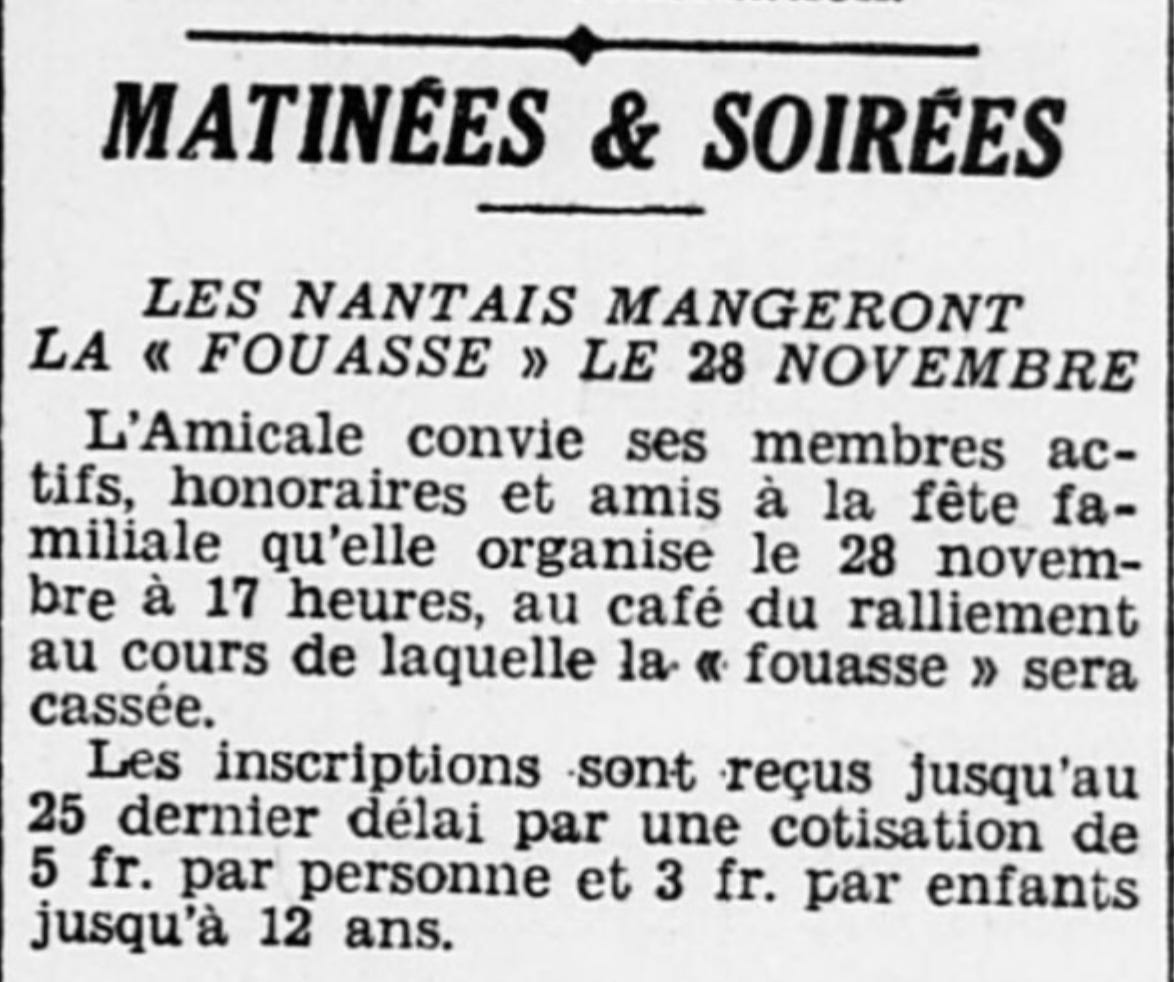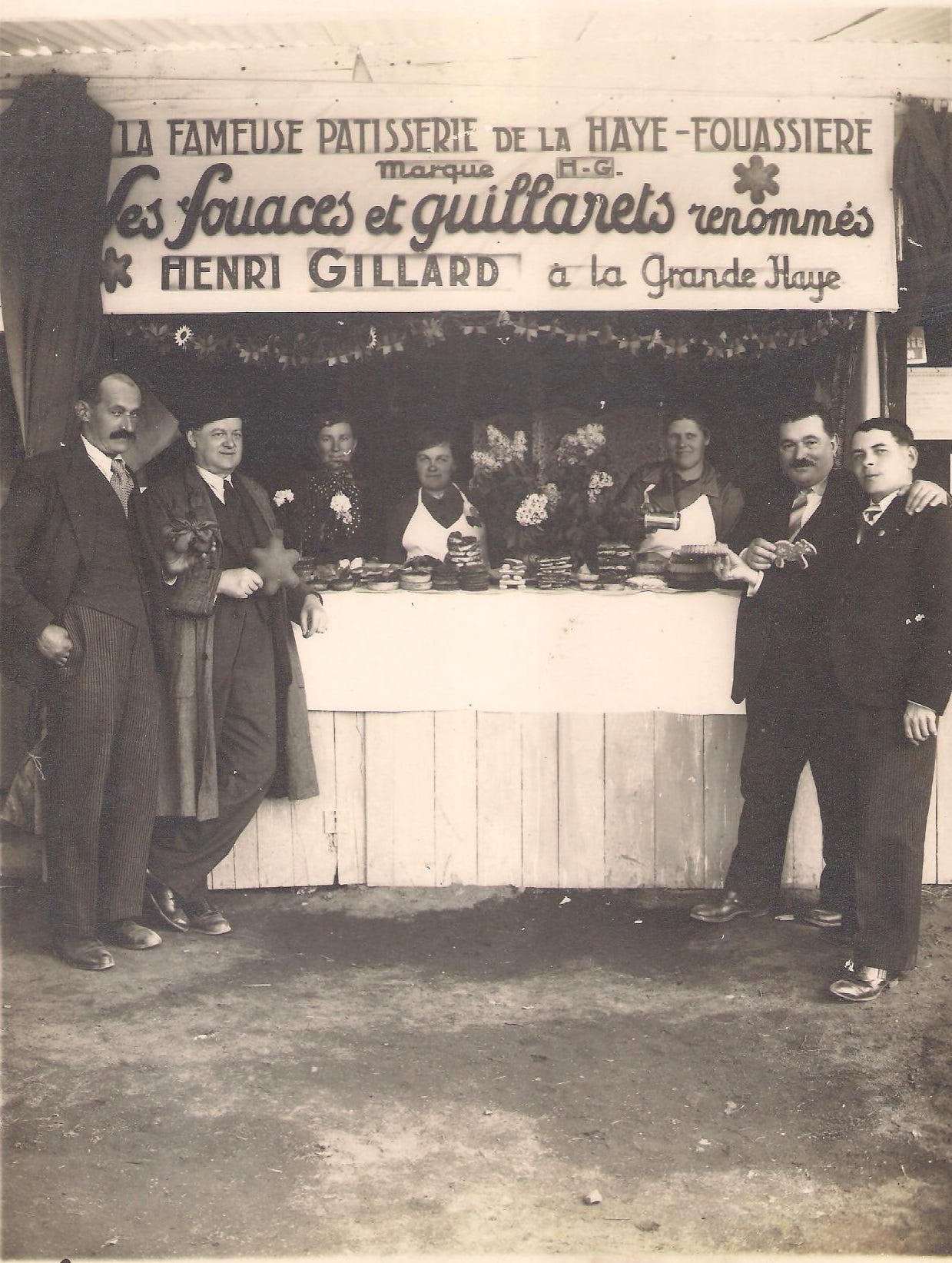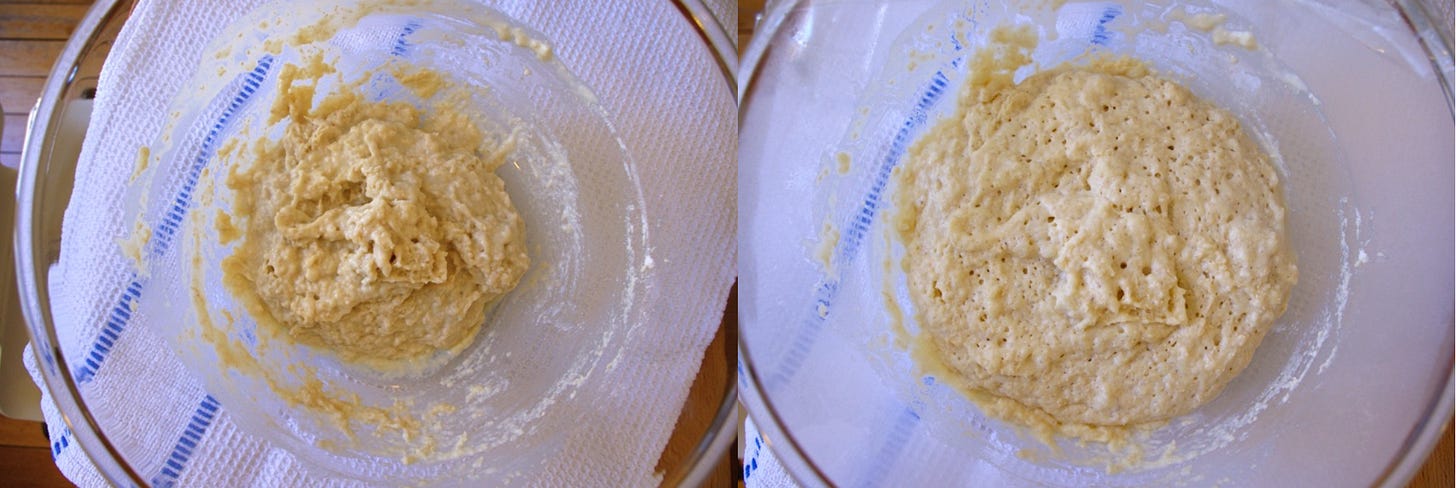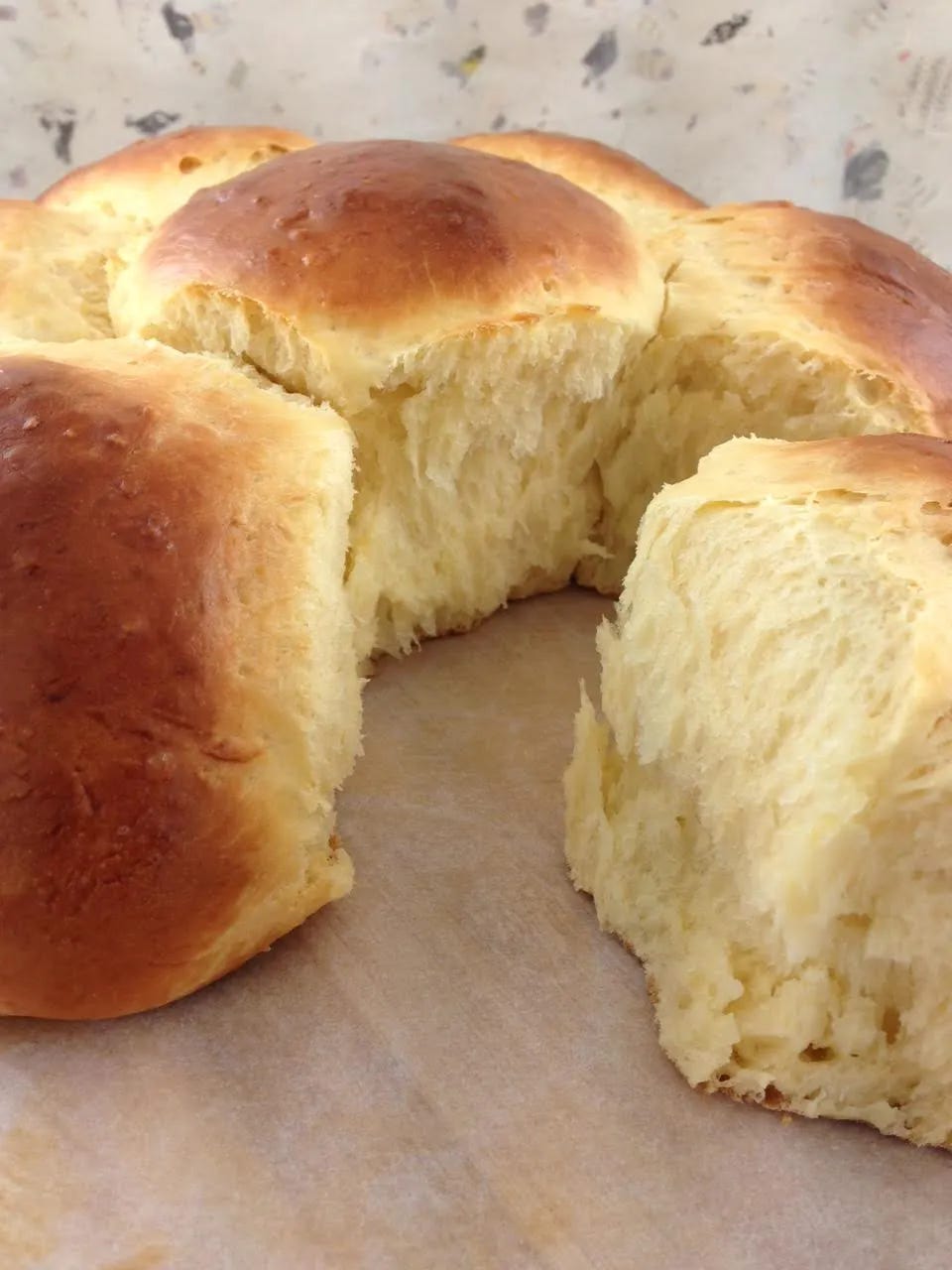Appetite comes with eating, but the thirst goes away with drinking. - François Rabelais
Fouace is almost like bread: it's the sweet treat that mothers, enemies of candy and pastries, allow their offspring to eat… L’Ouest Éclair, July 1919
I might live in the land of François Rabelais and the fouace de Lerné, better known now as the fouace rabelaisienne or the fouace du Chinonnais, but the first fouace I ever discovered, ate, and, of course, baked, was the fouace nantaise.
“Note that it's heavenly food to eat, fresh fouace with grapes at breakfast…” thus described Rabelais in the year 1534, as his local fouaciers… well, no, that venerable gargantuan tale is best left for another time. But Rabelais’ fouace, still made here in Chinon, the hometown of the great author and philosopher, by a mere handful of bakers, was special, a small round bread of fine wheat flour enriched with eggs, honey, spices, and walnuts. La fouace nantaise is lighter, less rustic, even as the fouace itself is an ancient rustic bread, traditionally baked directly in the ashes of a home kitchen fire. And while the fouace from the land of Rabelais is sweetened with the local honey, flavored with the region’s saffron and walnuts, the fouace from the region of Nantes is sweetened with sugar and delicately scented with orange flower water and rum.
The fouace is a cross between a bread and a pastry, somewhere between a sweet bread and a brioche, traditionally made by a specialized pâtissier-fouacier rather than the local baker. The 1938 Larousse Gastronomique informs “In every province of France, fouaces are made; in some regions they're called fougasse,” and every province makes a unique fouace flavored with the local products, some sweet, some savory. And while fouace and fougasse abound, and have for centuries, it’s almost impossible to find a recipe for fouace, most particularly the fouace nantaise, in any cookbook throughout time, a sign that it is not only extremely local, each region’s recipe never straying beyond its borders, but that it was always a bread made either at home or made and sold by itinerant street vendors.
“Fouace or fouasse,” wrote a contributor in the pages of L’Echo du Public in January 1899, “a cake made exclusively in Nantes and much appreciated by all my compatriots, is made with wheat flour and lightly buttered straight from the oven. Among the locals, this pastry is also known as guillaret….In my childhood, the Maison Rouleau on rue Saint-Clément had such a reputation that people would flock there from the farthest reaches of the city to snatch the fouaces as they came out of the oven. A fouace comes in three main shapes: a perfect round, star, and parallelogram. The star shape is particularly popular on Saint-Martin's Day, known here as the Feast of the Horns.”
Léon Brunschwicg, philosopher and historian, wrote Souvenirs d'un Vieux Nantais (Memories of an Old Nantais) in 1888 and cannot but write a few words about this most special local treat, one of his childhood:
“God knows how far back we have to go to pinpoint the date when the fouace nantaise (also known as guillaret) first appeared on the market. The shape of fouaces is not always the same. In the past, they were best seen as rosettes with five petals, baptized, I don't know why, with the unfortunate name of horns, but this didn't stop everyone from wearing them ostentatiously, in all honor, on Saint Martin's Day, when they returned from the assembly of horns. Today, the ancient form has become rarer, and the ordinary one used by our fouaciers - the word is not in the Académie Française dictionary - is rather reminiscent of a wallet closed on itself, golden on top and burnished underneath by the fire. Foreigners passing through Nantes take them home with them, as they would mother-of-pearl or ivory trinkets on which the engraver's chisel has inscribed the words: Souvenirs de Nantes.”
People flocking to a pâtissier-fouacier or strangers carrying them back home as cherished souvenirs…the fouace nantaise must be special indeed. Jean de La Fontaine, a French fabulist and one of the most widely read poets of the 17th century, highlights, if one notices, the exceptional quality of the fouace in his fable The Ear Maker and the Mussel Scraper in which his character sneakily offers broad beans in the place of peas, and white bread instead of fouace… “it's true,” he concludes, “that revenge was sweet.”

Although named “la fouace nantaise,” this pastry is actually thought to have originated in the neighboring commune of La Haie-Fouassière (or Haye-Fouassière), a small town stuck out in the middle of the vineyards of the famed muscadet wine. “There's a commune in our département called la Haie-Fouassière,” a journalist penned at the end of the 19th century, “either because fouace was created there, or because a lot of it is made there.” It is said that His Majesty Francois 1er, his court, and an entourage of other lords, did “go to la Haie-Fouassière once to eat fouaces and taste muscadet at Bacchus.” This makes it ancient, indeed, and very likely! Records kept at the Haie-Fouassière City Hall apparently mention the local fouace makers - les fouaciers - in 1530.
“Go to La Haie-Fouassière, and you'll see the resurrection of an industry from the Nantes region. The fouace, which was killed off by the (the first world) war, has made a comeback... two fouaciers who, for the past few weeks, have been working to revive the reputation of La Haie-Fouassière. You can't eat without drinking, and a warm fouace is only as good as a glass of muscadet: some people say that the people of La Haie-Fouassière invented the fouace just to sell their muscadet, others that they planted the vines to make their fouaces go down.” A writer for L’Ouest-Éclair newspaper in 1933 seems intent on rediscovering and reviving this local speciality. And this was not the first time he investigates the topic.
Writing a year earlier, in the June, 11, 1932 issue, the author, Count de la Cornillère, while admitting he is ignorant as to the origins of the fouace nantais, scoffs at those who claim that Rabelais, traveling from Angers to Nantes to Poitou could have possibly taken the time or had the impetus to teach the good people of la Haie how to make the fouace de Lerné. “They have a very fertile imagination.” Others, he states, claim that the aubergistes (innkeepers and bartenders) of La Haie created the fouace to make people thirsty, inciting them to purchase more to drink. “They’re just wicked gossips.” But, he concludes “We drink to digest the fouace, and eat fouaces to avoid getting drunk after Sunday mass.”
Wheat flour, from which Gringolette knew how to make golden and appetizing fouaces. - The New Children's Shop, Alexandre Dumas, 1860
Indeed, the first world war does seem to have killed off the production of this treat. In 1914, there were 18 fouaciers in the town of La Haye-Fouassière; in 1900, there were close to 100 fouaciers in Nantes and the region. At the time the article for L’Ouest-Éclair was written in 1933, there were just 2. One can easily find news during both world wars of restrictions and rationing, flour, sugar, and other ingredients, that hit pâtissiers and fouaciers particularly hard. “Our good fouaciers are nonetheless protesting against the ruling that condemns them, in the name of every citizen's right to live off the fruits of his labor.” (January 1918) - “The fouacier is sorry, but, given the circumstances, he can't do any better, and he's happy to be able to work until further notice. The flour is not first choice and the sugar is lacking. He fears he'll have to abandon it all soon and lose his livelihood.” (January 1941).
Poor M. Gaillard who, with his colleague, tried to revive the fouace industry in La Haie-Fouassière back in 1933. “Mr. Gaillard is going to modernize the old industry” said the article, “…a mechanical kneading machine powered by electricity...yeast will replace sourdough...the fouace will be softer, the mass will be aerated, the guilleret will have a rounder shape. It looks more golden and appetizing than the old cake, and yet it's made with only the purest, finest flour, fresh butter and sugar, no chemical ingredients.” I wonder if they were able to survive the second world war and the rationing.
"In the name of Rabelais, Saint-Honoré, patron saint of bakers, Dionysus, god of wine, and Curnonsky, prince of gastronomes, I make you ambassador of the Brotherhood of the Fouace of the Nantes vineyards.” This is the oath taken upon being inducted into the Confrérie de la Fouasse du Vignoble Nantais. I’m not sure if anyone still makes fouaces nantais regularly, but this brotherhood has been gathering since 2005 to research, preserve, promote, record, publicize, and develop the original recipes of fousasse and fouassiers. But every year, La Haie-Fouassière does celebrate the traditional fouace and the local muscadet wine with the event Fouace et Muscadet en Fête.

More brioche than bread, this version of the fouace nantaise is light and delicate, slightly drier and less sweet than the traditional Parisian brioche, but beautifully scented with the city’s traditional orange flower water and dark or amber rum. I made the star shape, also called a macaron (see the Michelin Guide’s famous macaron and you’ll understand). The dough is separated into 7 equal parts of equal size, one for the center round, the other 6 for the outer “horns”.
As for any brioche, the fouace is best eaten fresh the day it is baked, but will last for another day or two. The fouace, especially stale, is perfect to make French toast. Feel free to increase the sugar by 1/4 cup and to add the finely grated zest of an orange for a slightly sweeter brioche with a more pronounced orange scent.
Fouace Nantaise
1 pound (500 grams) flour, divided, plus more for kneading
2 ¼ teaspoons (8 grams) active dry yeast
¼ cup (50 grams) sugar
½ cup (115 ml) milk, warmed to body temperature but not hot
½ teaspoon salt
7 tablespoons (100 grams) unsalted butter, softened to room temperature
1 small juice or wine glass of rum, about 3 ounces (90 ml)
1 tablespoon fleur d’oranger (orange flower or orange blossom water)
4 eggs, preferably at room temperature, lightly beaten
1 additional egg for egg wash, lightly beaten
Place 1 cup (130/140 grams) of the flour in a small-to-medium-sized mixing bowl with all of the yeast and 1 teaspoon of the sugar. Add the warm milk and stir briefly just to wet all of the dry ingredients.
Allow to proof for 30 – 40 minutes or until almost doubled in size, puffy, and bubbly.
While the yeast mixture is proofing, place the rest of the flour in a large mixing bowl with the salt, the remaining sugar, the softened butter, the glass of rum, the orange flower water, and the 4 lightly beaten eggs. Stir with a wooden spoon until all of the dry ingredients have been moistened and the mixture is well blended.
Add the proofed yeast mixture and stir together until well blended. It will be very sticky.
Scrape the dough onto a very well floured work surface and dust the sticky dough with a bit more flour. Knead the dough vigorously for about 6 minutes, adding more flour as needed, until the butter and the yeast mixture are well incorporated and the dough is no longer sticky; you should have a soft, smooth, elastic, and homogenous dough.
Divide the dough into 7 equal portions (I use a scale); form each portion into a smooth ball.
Place one in the center of a large, parchment-lined baking sheet/cookie tray. Place the other balls of dough around the outside of the center ball to form a “star” shape making sure that the outer ring of dough balls touch the center ball.
Cover the fouace lightly with a piece of plastic wrap then a clean kitchen towel and allow to rise until doubled in size, about 2 hours.
Preheat the oven to 350 degrees F (180 degrees C).
Brush the dough with the beaten egg and bake for 30 – 40 minutes until risen and a lovely, deep golden brown. The “horns” of the star may have just started to pull away from the center ball of brioche.
Thank you for reading and subscribing to my Substack Life’s a Feast. Please leave a comment, like and share the post…these are all simple ways you can support my writing and help build this very cool community. If you would like to further support my work and recipes, please consider becoming a paid subscriber. It’s truly appreciated.










Looks wonderful!
oh that looks just delightful. it's so satisfying to make this kind of thing, thanks for sharing its history!
I use my bread machine to prep the dough, on the "dough only (no baking)" setting. haven't tried this recipe yet but I've done it many times for brioche and Kugelhopf and it turns out perfect. 🙂